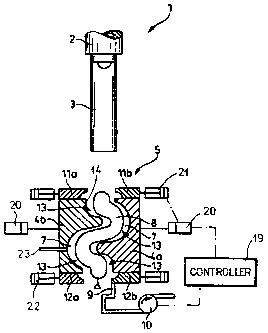Some of the information on this Web page has been provided by external sources. The Government of Canada is not responsible for the accuracy, reliability or currency of the information supplied by external sources. Users wishing to rely upon this information should consult directly with the source of the information. Content provided by external sources is not subject to official languages, privacy and accessibility requirements.
Any discrepancies in the text and image of the Claims and Abstract are due to differing posting times. Text of the Claims and Abstract are posted:
| (12) Patent: | (11) CA 2358249 |
|---|---|
| (54) English Title: | MOLD FOR SUCTION/BLOWING SYSTEM |
| (54) French Title: | MOULE POUR SYSTEME D'ASPIRATION ET D'EVACUATION |
| Status: | Expired and beyond the Period of Reversal |
| (51) International Patent Classification (IPC): |
|
|---|---|
| (72) Inventors : |
|
| (73) Owners : |
|
| (71) Applicants : |
|
| (74) Agent: | NORTON ROSE FULBRIGHT CANADA LLP/S.E.N.C.R.L., S.R.L. |
| (74) Associate agent: | |
| (45) Issued: | 2009-09-08 |
| (22) Filed Date: | 2001-10-04 |
| (41) Open to Public Inspection: | 2002-04-06 |
| Examination requested: | 2006-07-05 |
| Availability of licence: | N/A |
| Dedicated to the Public: | N/A |
| (25) Language of filing: | English |
| Patent Cooperation Treaty (PCT): | No |
|---|
| (30) Application Priority Data: | ||||||
|---|---|---|---|---|---|---|
|
A molding apparatus has a pair of mold halves having faces engageable together to form a nonstraight passage having an intake end and an output end, extruder means for forming a hollow plastic preform and feeding it to the intake end of the passage, pump means connected to the output end of the passage for drawing gas therefrom and thereby applying drawing the preform through the passage, and a seal carried on one of the faces, extending along the passage, and engaging the other of the faces for preventing gas flow between the faces into the passage when the mold halves are closed together.
Un dispositif de moulage constitué d'une paire de demi-moules dont les deux faces réunies forment un conduit non droit, comprenant un orifice d'admission et un orifice d'expulsion, un dispositif d'extrusion pour former une coquille de plastique creuse préformée, qui est insérée dans le moule par l'orifice d'admission; d'une pompe raccordée à l'orifice d'expulsion pour aspirer les gaz dégagés et aspirer la forme pré-moulée dans le conduit et sur un sceau, disposé dans l'une des demi-moules, étirer la forme dans le conduit et rapprocher les deux demi-moules pour prévenir l'aspiration entre les faces du moule fermé.
Note: Claims are shown in the official language in which they were submitted.
Note: Descriptions are shown in the official language in which they were submitted.

2024-08-01:As part of the Next Generation Patents (NGP) transition, the Canadian Patents Database (CPD) now contains a more detailed Event History, which replicates the Event Log of our new back-office solution.
Please note that "Inactive:" events refers to events no longer in use in our new back-office solution.
For a clearer understanding of the status of the application/patent presented on this page, the site Disclaimer , as well as the definitions for Patent , Event History , Maintenance Fee and Payment History should be consulted.
| Description | Date |
|---|---|
| Common Representative Appointed | 2019-10-30 |
| Common Representative Appointed | 2019-10-30 |
| Time Limit for Reversal Expired | 2019-10-04 |
| Letter Sent | 2018-10-04 |
| Grant by Issuance | 2009-09-08 |
| Inactive: Cover page published | 2009-09-07 |
| Inactive: Final fee received | 2009-06-05 |
| Pre-grant | 2009-06-05 |
| Notice of Allowance is Issued | 2009-02-04 |
| Letter Sent | 2009-02-04 |
| Notice of Allowance is Issued | 2009-02-04 |
| Inactive: IPC removed | 2009-01-30 |
| Inactive: Approved for allowance (AFA) | 2008-12-11 |
| Letter Sent | 2006-08-11 |
| Request for Examination Requirements Determined Compliant | 2006-07-05 |
| Request for Examination Received | 2006-07-05 |
| All Requirements for Examination Determined Compliant | 2006-07-05 |
| Inactive: IPC from MCD | 2006-03-12 |
| Inactive: IPC from MCD | 2006-03-12 |
| Letter Sent | 2002-11-04 |
| Inactive: Correspondence - Transfer | 2002-10-22 |
| Inactive: Single transfer | 2002-09-17 |
| Amendment Received - Voluntary Amendment | 2002-09-17 |
| Application Published (Open to Public Inspection) | 2002-04-06 |
| Inactive: Cover page published | 2002-04-05 |
| Inactive: First IPC assigned | 2001-12-05 |
| Inactive: Courtesy letter - Evidence | 2001-10-23 |
| Inactive: Filing certificate - No RFE (English) | 2001-10-17 |
| Filing Requirements Determined Compliant | 2001-10-17 |
| Application Received - Regular National | 2001-10-16 |
There is no abandonment history.
The last payment was received on 2008-09-25
Note : If the full payment has not been received on or before the date indicated, a further fee may be required which may be one of the following
Please refer to the CIPO Patent Fees web page to see all current fee amounts.
Note: Records showing the ownership history in alphabetical order.
| Current Owners on Record |
|---|
| SIG BLOWTEC GMBH & CO. KG |
| Past Owners on Record |
|---|
| DIRK WEHRENS |
| FRANK SCHULLER |
| WILLI DOHMEN |